A shawl crocheted from the base has practically no differences from the pattern from the corner. The only difference is that when knitting from the base, the loops must be symmetrically reduced on each side, and when making a product from the corner, they should be added in the same way. When changing the knitting direction, the beauty of the pattern does not deteriorate, and sometimes it looks even better if you take into account the nuances of knitting fashionable novelties of 2024.
How to knit a shawl from the corner
A crochet shawl (the pattern from the corner is symmetrical) can be made either from the central part or from the right or left edge. It depends on the model you choose and the hook you use.
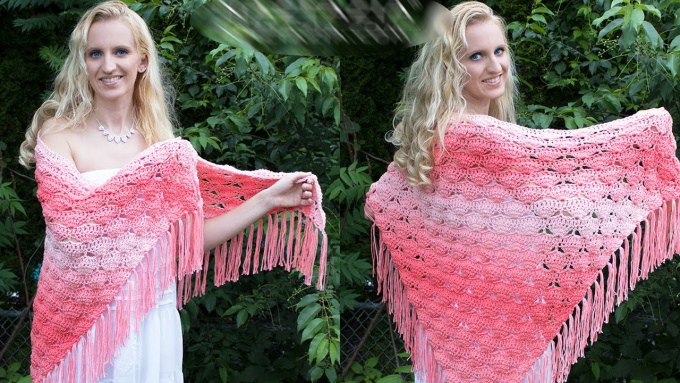
If the shawl is made of a single piece of fabric, then you should start with several air loops that make up the central corner. The chain of such loops includes the initial and lifting loops for the next row. Depending on which column the next row begins with, the number of lifting loops is determined.
So, a single crochet corresponds to 2 chain stitches, a double crochet corresponds to 3, a double crochet corresponds to 4, and so on. This should always be remembered, because the shape of the product depends on the correct design of the side edges.
If there are not enough lifting loops, the shawl will be too tight at the edges, which will lead to deformation of both the fabric itself and the finished product. As a result, its base will not be even, but convex, the sides will be pulled together.
If there are more lifting loops than required by the pattern, the bevels will fold, which will also lead to a deterioration in the appearance of the shawl. In this case, the base will become concave, and the edges of the fabric will be stretched upward.
Before starting work, you need to carefully study the pattern diagram and correctly calculate the number of lifting loops for each row.
It should also be noted that the number of lifting loops in subsequent rows may be different. This depends on the chosen pattern. Therefore, when knitting, you need to carefully follow the pattern.
If the model involves knitting a shawl from individual motifs, be it:
- round;
- hexagonal;
- diamond-shaped;
- triangular,
then you should keep in mind that you need to start working with one, increasing each subsequent row by one more motif. It should be noted that when choosing a pattern from round fragments, you may subsequently need to knit smaller elements to fill the gaps between motifs.
This is mainly found in shawls made of large round fragments. The next point that requires attention when making products from hexagonal, diamond-shaped and round motifs is the alignment of their base, if this option is provided by the chosen model.

To do this without distorting the main pattern, it is recommended to carefully study the pattern scheme and the possibility of doing it in half size. Such half-fragments fill the empty spaces in the outer row of the product.
When knitting shawls from triangular motifs, there is no need for such a technique, since they are arranged alternately with the base and angle to each other in each subsequent row. With this combination, they eliminate the formation of inter-motif voids.
In addition to working from the central corner of the shawl, there is a method of knitting from the right or left corner. This method is used when making baktus shawls with a Tunisian crochet hook. It differs from the usual tool by a long handle of one diameter, which acts as a knitting needle.
This type of shawl has become very popular among modern women, as it can be used in various interpretations and give the main suit or dress a complete and feminine look. More detailed information on the execution of such a model will be presented below.
Knitting patterns for shawls from the corner
Patterns of shawls crocheted from the corner have some advantage over products made from the base. It consists in the possibility of adjusting the length and width of the fabric.
In most cases, such a need arises when choosing yarn that does not match the one stated in the example or the selected model. Therefore, having bought the threads you like, do not be upset if they do not fit the selected pattern, but rather look for a similar pattern, performed from the corner and start working.
Made from solid fabric
The patterns below are designed for knitting shawls from the bottom corner and provide for straight side edges.
According to the list of symbols, the pattern involves columns with 1 yarn over, which corresponds to three air loops of lifting at the beginning of each subsequent row. Thanks to this combination, the product will retain the correct triangular shape.
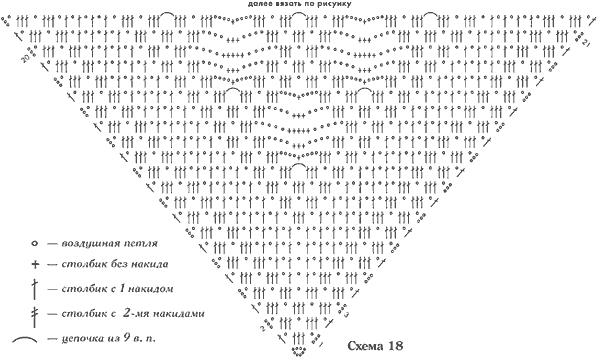
The following diagram, due to the specific features of the pattern, namely the figured alternation of different combinations of loops, suggests using 4 air lifting loops to give the finished fabric the necessary shape.
After finishing the work, the base and sides of the product can be decorated with a frame. Moreover, in most cases it differs from each other both in density and width. The foundation prefers a narrow but dense strapping.
In contrast, the side edges are decorated with wide openwork. When choosing the type of binding, it is recommended to compare the main pattern with it and choose more comparable and compatible options.
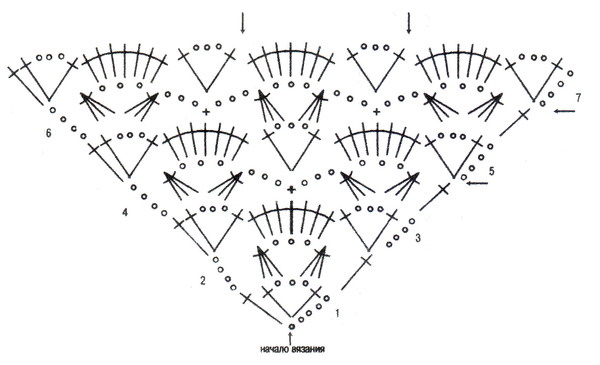
This pattern is a pattern of larger parts on an openwork base. As can be seen from the picture, the sides of the product are designed in the form of periodic inflows, connected from lifting air loops.
But this model has a nuance that does not allow the finished fabric to lose the necessary shape. These are columns with 1 yarn over, connected immediately after the lifting loops, made in a larger quantity than necessary to maintain an even edge.
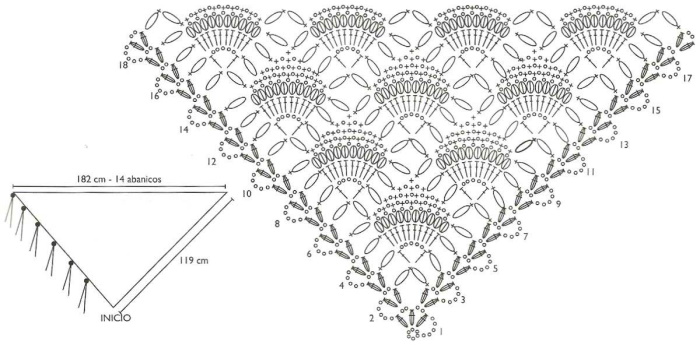
This technique is used by craftsmen for further decoration of the shawl with tassels. They are placed in several threads in each formed wave-like loop. In such examples, on the Internet and in knitting magazines, you can choose the most diverse options for pattern schemes to make your dream come true.
From hexagonal motifs
The crochet shawl, the diagram from the corner of which is presented below, is an example of a product made from hexagonal motifs. In order for the pattern of the fabric to be uniform and identical, fragments must be selected only with an even number of corners. Otherwise, its integral ornament will be disrupted.
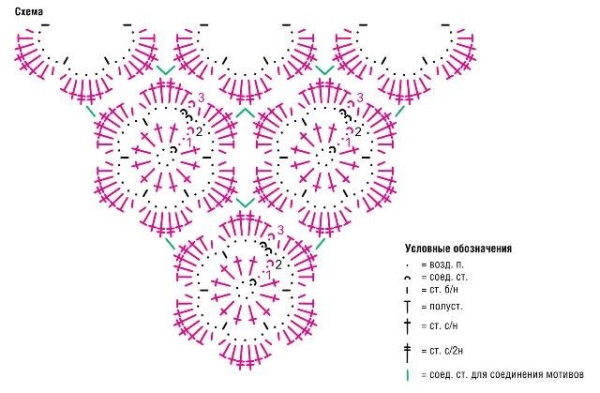
Such motifs are well connected to each other and eliminate the formation of free space that requires further filling with additional details. Products from individual motifs can be made in one or several colours.
This allows you to create exactly the combination of shades that will harmoniously or contrastingly match the main suit. Hexagonal elements can contain a geometric or floral pattern. It itself is a complete motif of the pattern or together with other motifs makes up a general integral ornament.

When knitting the outer row of the base, remember that it is necessary to make several half-pieces in it to create an even edge. The difference in knitting a half element is in the forward and reverse direction of work, while the full motif is knitted in a circle.
From diamond-shaped elements
There are many options for making shawls from diamond-shaped pieces. Any square motifs arranged in the shape of an equilateral rhombus are suitable for this knitting method.
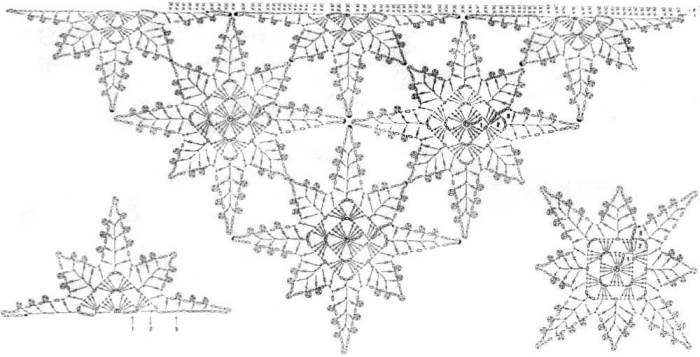
In the given example of the scheme, the fragments are peculiar snowflakes, connected to each other by sharp ends. When decorating the main edge, halves of the motifs are also used, the scheme of which is given nearby. Such a model looks very gentle, elegant and feminine.
The following pattern is a square motif that will successfully fulfill the role of a rhombus in the product. By adding one motif in each subsequent row, the sides of the shawl are smooth and beautiful. The main thing is to carefully follow the pattern diagram and correctly connect the fragments together.
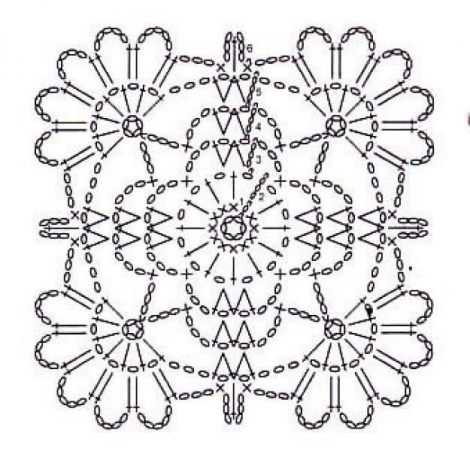
This process is carried out in two ways:
- while knitting the outer row of the motif;
- after all parts have been manufactured.
According to the advice of experienced needlewomen, the first option for joining the fragments of the product is more effective, beautiful and reliable.
From round fragments
The crochet shawl (the diagram from the knitting corner is presented below) is a more complex option.
The difficulty of its implementation lies in two points:
- precise calculation of the points of adhesion of fragments to each other;
- filling the inter-motive space with additional details.
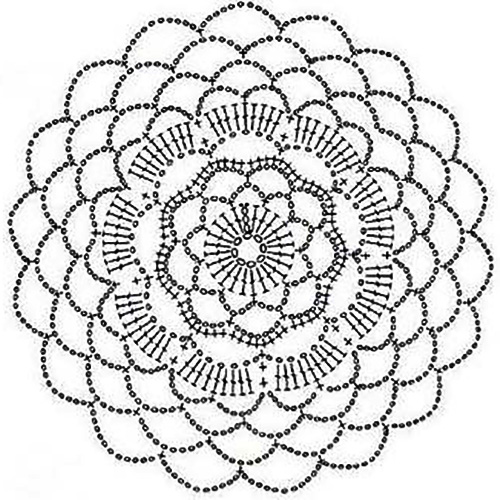
Depending on the size of the gaps between the motifs, they can be closed with the central part of the main element or a suitable pattern can be selected that matches the diameter of the space. It is impossible to do such an operation offhand.
When choosing correctly, it is necessary to connect several selected options and compare them with the inter-motive gap. The one that fits most accurately into the pattern and the main fabric should be included in the work.
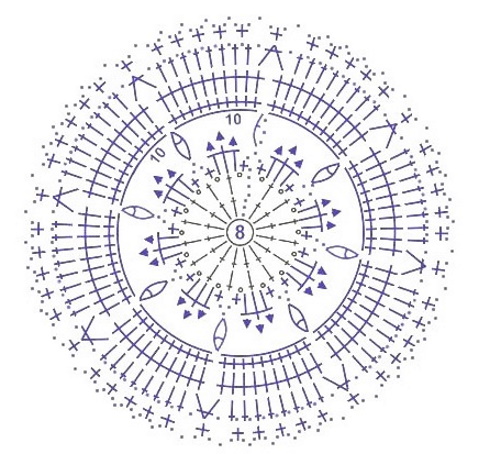
For beginner knitters, experienced craftswomen advise to mark the joining points with a contrasting thread before joining the parts together. This will make the work easier, eliminate further mistakes and the need to unravel an incorrectly knitted fabric.
When decorating the outer row of the base of a shawl knitted from round motifs, it is better to fill the resulting free cells with the same details that cover the spaces between motifs.

Such products can be made in one color or in several variations. A combination of two shades of one color will look great, large motifs - darker, small ones - lighter or vice versa.
From triangles
A beautiful and non-involving option for knitting shawls is a fabric made of triangular elements. Its exclusivity and uniqueness lies in the creation of large patterns created by triangular details.
All of them are knitted from the center and have an equilateral structure. Therefore, their coupling is easy and clear. The nuance of this method of knitting the fabric is the alternate arrangement of the fragments relative to each other.
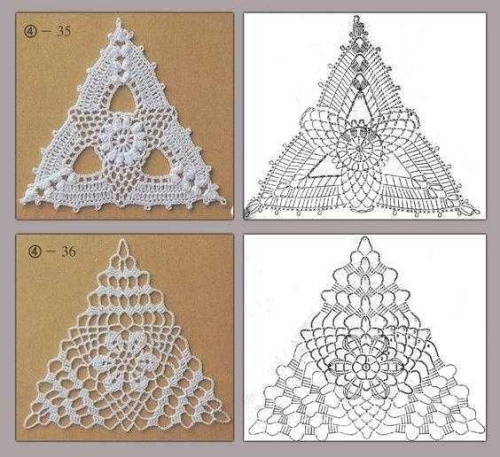
Models of products connected in this way do not require additional filling of free formations when designing the base.
Baktus with Tunisian crochet hook
The crochet shawl (the pattern from the corner, made in the technique of Tunisian crochet, has its own unique charm and appeal) in various variations appeared on the crest of fashion and immediately gained enormous popularity among modern women.
The delicate and light structure of Tunisian crochet, as well as the many ways of its application, made baktus an essential accessory in the wardrobe of the female population.

As mentioned at the beginning of the article, Tunisian crochet requires a special long hook with the same diameter throughout the entire handle. In this technique, it acts as a knitting needle, onto which loops are hung in the front rows during the work.
The resulting fabric is very similar to a pattern knitted with knitting needles. Therefore, knitters who only know how to crochet can also create an analogue of a product made with knitting needles. The difference in the Tunisian technique is that it knits in straight and reverse rows without turning the work.So, knitting this model of baktus begins with an acute angle.
Its shape is not similar to standard shawl styles and is a scarf with one right angle and one sharp angle:
- To start working, you should dial a chain of 3 air loops. The first of them will be the beginning of knitting, and the remaining 2 - loops for lifting to the next row.
- The second row consists of making 3 double crochet stitches in the initial chain stitch. Then make 2 chain stitches and turn the work.
- The next row is a set of loops on the hook. This is done starting from the second lifting loop. The hook must be inserted into it, grab the working thread and leave the resulting loop on the hook handle. Then pick up the thread under the vertical arc of the first column with 1 yarn over and again leave the loop on the hook.
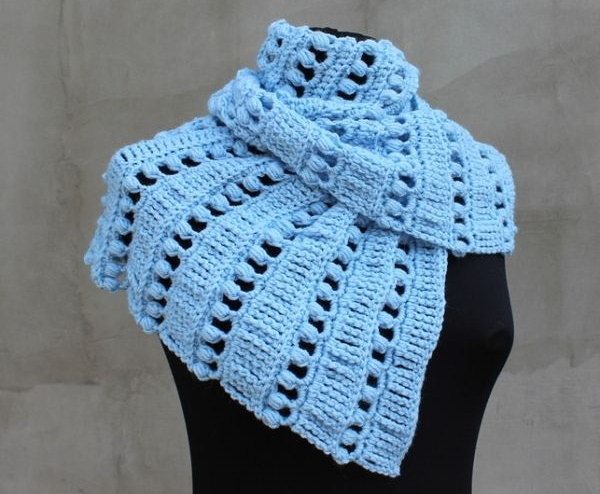
Do this until the end of the columns. Together with the edge loop on the hook handle, there should be 5 pieces. Such rows with a set of loops are called straight.
- Then knit the reverse row. It consists of the following: grab the working thread and pull it through the outer loop. Then grab the thread again and pull it through the next 2 loops.
Continue working in this manner until the end of the loops on the hook. It should be noted that the reverse rows are performed from left to right, that is, from the end of the row to its beginning.
- The next row starts with the remaining loop on the hook and is done from right to left. After the initial loop, pick up the working thread under the vertical arc of the post of the previous row and continue working like this until the edge loop. Again, there are 5 loops on the hook.
- The reverse row is performed in the same way as described above.
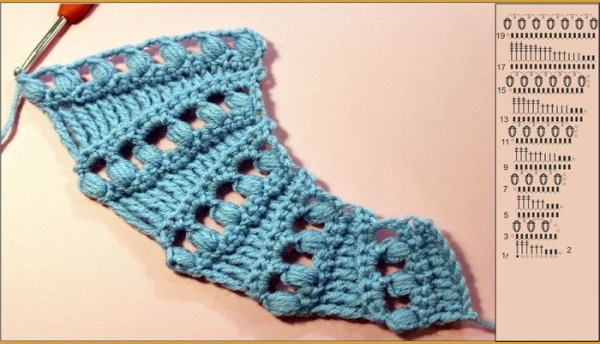
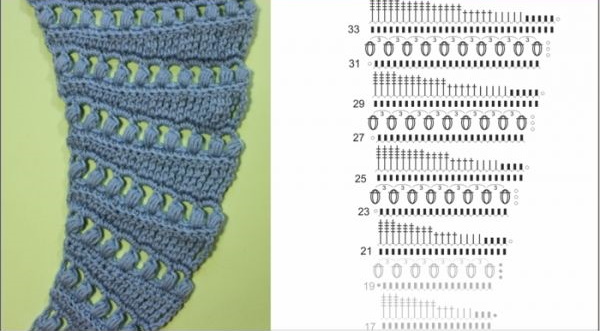
The repetition of the number of direct and reverse rows in the same quantity depends on the style of the baktus. If the model has a longer and sharper end, the number of rows with the same number of loops can be increased. Otherwise, their number can be limited to 1-2 repetitions.
To further design the expansion of the side edge of the shawl, at the beginning of the straight row, you should knit another air loop. And the set of loops is carried out not from the column of the previous row, but from the second air loop.
Thus, expanding the fabric evenly through a certain number of rows, knit to the required width of the shawl. At the end of the work, close all the loops in one reverse row.
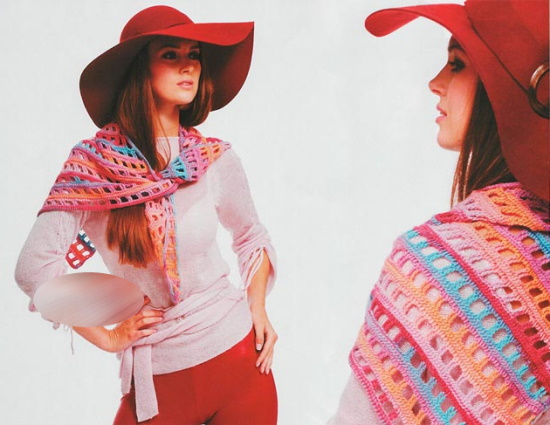
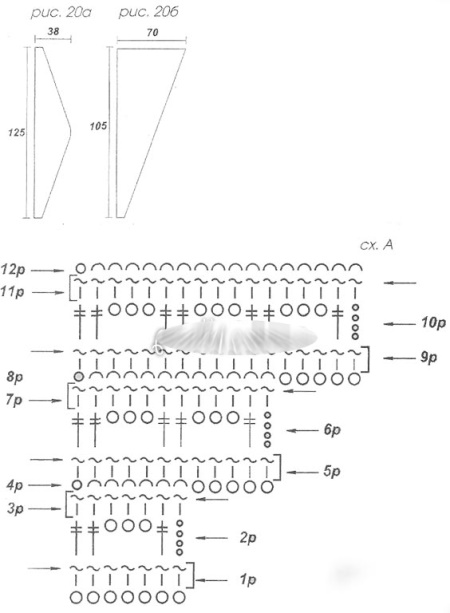
Then it's a matter of fantasy. Such a baktus can be fixed on the neck with a decorative pin or brooch. It is possible to design the shawl in the form of uniform soft folds, when its sharp edge passes through identical slits.
They are knitted in the process of work along the short even edge of the product. The finished baktus does not need mandatory piping, but can be decorated with it if desired.
Irish lace
The most difficult, but at the same time incredibly beautiful option for making corner shawls is Irish lace. The pattern of such a product cannot be repeated, so each of them is an exclusive and unique masterpiece of the master.
Fragments of Irish lace can fill the entire space of the shawl or serve as a kind of decoration in combination with a simpler and more uniform pattern.
Before starting to work in this technique, experienced needlewomen recommend making a pattern of the product of the required dimensions. Then choose the style of connection of individual parts, whether it will be a connection between the elements themselves or carried out using an irregular grid.
After this, the required number of component parts are made, they undergo wet-heat treatment to acquire the final shape, and then they are placed on the pattern.

If the "picture" of the pattern is folded and satisfies the knitter, the fragments are secured on the pattern for subsequent joining. It is advisable to decorate the finished shawl with a binding that most closely matches the configuration of the majority of the details.
If beginner knitters really want to knit a shawl using this technique, but do not have enough experience yet, they can try their hand at a method that imitates Irish lace.
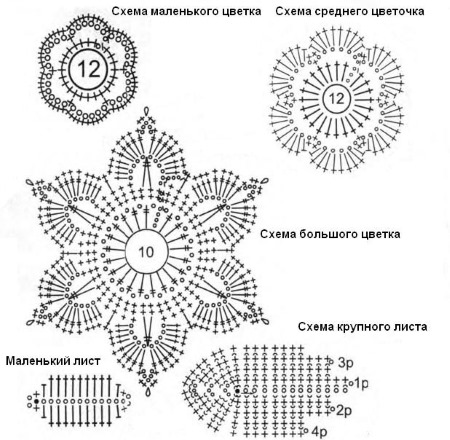
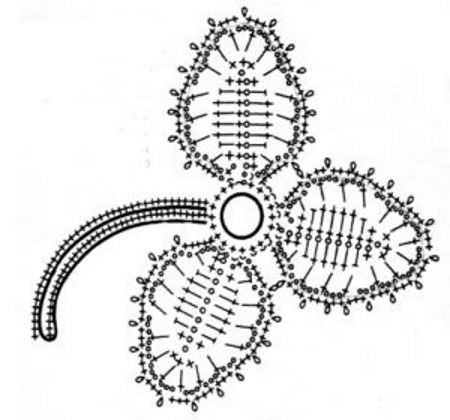
To do this, you first need to knit the base of the product in the form of a regular grid corresponding to the selected dimensions, and then sew individual parts onto it.
Any woman who wants to have a unique and fashionable item in her wardrobe, and who has even basic crochet skills, can make it herself.
Shawls crocheted using patterns from the corner are not particularly difficult if you follow the advice and recommendations of experienced craftsmen presented in this article.
Video about knitting
Crochet shawls. Knitting patterns:

Thank you